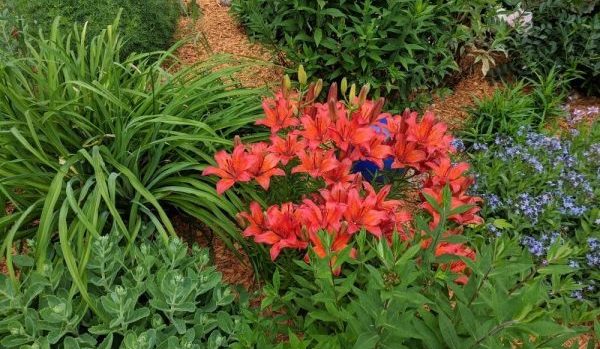
Top 8 ‘Tough as Nails’ Perennials
When it comes to plants, reliable is a characteristic we love! This is our top 8 ‘tough as nails’ perennials that will come back every year and tolerate a wide array of conditions. We would like to mention, even though they are tough, it doesn’t mean they can be completely neglected of nutrients, sun, and water. These plants, after their first couple years of more watchful care, will definitely catch your attention with their beauty, tenacity and reduced level of care once established.
Yarrow

Yarrow Vintage Rose with Salvia in the background.
Achillea millefolium is a Native American plant. Yarrow adds light texture to a garden and one of the best low care perennials for adding a burst of color. It grows tall ( can be up to 3′-4′) with showy clusters of fragrant white, red, pink, or yellow flowers, depending on the variety. It does well in hot and dry spots and resistant to pests. Their blooms typically last from early summer through early fall and are a wonderful cut flower!
Feather Reed Grass

Feather Reed Grass
Calamagrostis x acutiflora is an upright clump forming ornamental grass, with multiple varieties, that adds architecture, movement, and the seed heads add floating fluffy textures in the fall through winter. It does best in moist, rich soil but can handle poor, dry soils as well. This is the perfect grass for urban areas and tough to grow sunny areas. In addition to its high tolerance for multiple conditions, it is pest and disease resistant. Prune down foliage to a couple inches above soil before new growth in the spring and add organic fertilizer if it’s in poor soil if you want to give it a boost and that’s it!
Phlox
There are so many varieties of phlox it’s impossible to describe them all but they come in low, medium, and tall growing forms to fit in just about any garden. It’s one of the most versatile and colorful plants that have been used in gardens for over 100 yrs and for good reason. Most are long-blooming, often fragrant, and tall varieties don’t require staking. They prefer moist, rich soil and full sun, but depending on the variety, some don’t mind poor, rocky soils or part-sun. Flower colors range from pure white to red, with nearly every shade of pink, lavender, salmon and purple and some multi-colored petals. With proper planting, you can avoid most disease issues, such as powdery mildew.
Daylily
Hemerocallis means “beauty for a day”because daylily buds blooms only one day but has successive blooms over 4-5 weeks. Some daylily varieties are labeled rebloomers since they perform a couple times in the season with successive blooms. The Daylily is considered “a perfect perennial” because it’s drought tolerant, can grow in almost any kind of soil, can grow in full or part-sun, offers an array of early season to late season blooming varieties, has showy vibrant colors, are pest and disease resistant, and attracts birds, bees, and butterflies. Can be grown on hillsides, around the city, or in a traditional garden with very little care needed.
Sedum
Sedum, also called stonecrop, have thick succulent like leaves that form clusters of small colorful flowers (white,red,pink,or yellow) in late summer and fall that bees love! There are low-growing and tall varieties that love full sun and can handle drought conditions. Once these plants are established they require almost no care. Sedums are easy to split in spring and fall if they get too big for their space. These perennials can grow quickly! Foliage of the fleshy leaves are not only green but there are varieties with varying foliage colors. For example, Sedum Dragon’s Blood Tricolor has white and green foliage with pink edges or deep purple leaves like Sedum Dark Magic. Just make sure these plants have well-draining soil because they can succumb to root rot in prolonged wet soil.
Coneflower
Echinacea, comonly known as Coneflower are bright, upright, and tough perennials! They can take the heat and drought conditions once established ,deer resistant, and trouble free! Echinacea purpurea is the native coneflower to North America but there are varieties with many different bloom colors. These flowering perennials can have blooms that last from mid-summer though fall! Give coneflowers full sun and avoid other plants shading them. They don’t need much in regards to fertilizer if you mix in plenty of compost into the soil when planting. They attract bees and butterflies and if you leave the flowers on in the fall, birds like to eat the seeds. Prune off dead flowers in summer to promote more blooms for fall.
Russian Sage
Perovskia atriplicifolia, commonly known as Russian sage is a must have plant to add to your garden! Russian sage has grey-green leaves that are very aromatic with bluish-purple flowers that bloom mid-summer through fall. It can tolerate clay soil, dry soil, street salt, and are deer and rabbit resistant. It’s also disease and pest resistant! It really is a tough plant! They can fill up a 3′-4’x3’x4′ space in your garden quickly. Birds, bees, and hummingbirds will appreciate this valuable addition as well!
Hyssop
Agastache, or commonly known as Hyssop or Butterfly Mint, have very fragrant foliage and flowers that attract bees and butterflies. The flowers bloom late summer through fall to add color when other perennials are winding down. Most hyssop varieties are native to North America and not only like compost rich soil but also lean, dry soil. They prefer a “tough love” approach so they don’t need much water once established and be sure not to over-fertilize. Only top-dress with compost in spring if you want. Hyssop prefer full sun but can tolerate part sun areas.






